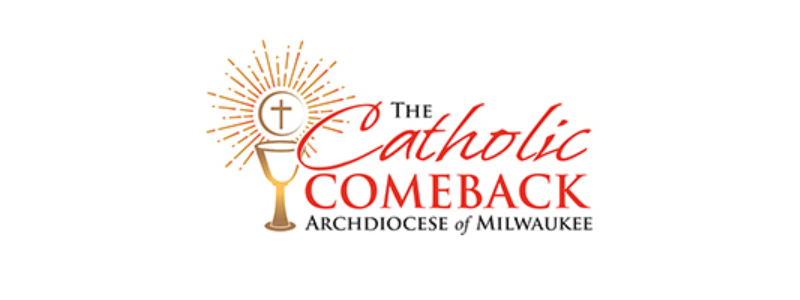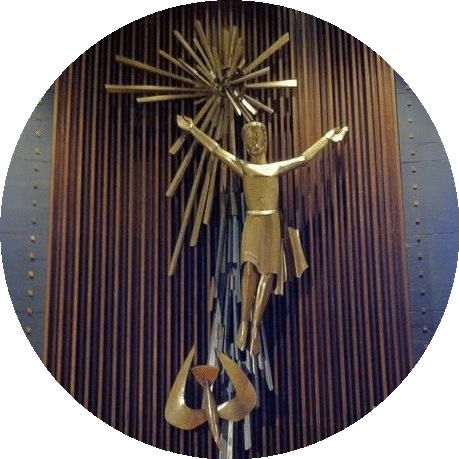
April 30, 2020
Dear Brothers and Sisters in Christ,
Archbishop Jerome Listecki shared this information today with Diocesan Priests, Parish Directors, Religious Order Priests in Parishes and Permanent Deacons, and also discussed it with them on a Conference Call this afternoon. We wanted to share this information with you directly as well.
As Catholics, the Eucharist is the “source and summit” of our spiritual lives. Being deprived of the public celebration of the Mass has been a tremendous hardship for both our people and our priests, who long to serve their people. As a Sacramental Church, the reception of Communion is an integral part of our faith and worship. We recognize how truly lost and empty we are without the Holy Sacrifice of the Mass and without the reception of Jesus Christ, truly present in the Eucharist.
Now we look ahead to the time we return to celebrating Mass with our parish communities. We want to do this in a reasonable and responsible way, with the safety of our people and respect for our sacramental life our top priorities. To that end, we are issuing these directives, guidelines and considerations, to aid our parishes in the resumption of public Mass and demonstrate our commitment to protecting communities.
We understand the seriousness of this pandemic. We also understand the strong desire of our people to come together to worship God and these directives provide both a reasonable and responsible way to make that happen in the coming weeks.
Pandemic-induced anxieties, confinement to homes, fear of catching the virus, unemployment, and financial uncertainty have left people fearful and distressed. It is at times like these when the Church is most needed, bringing her message of faith, hope, and charity.
The Church, at its best, addresses and assists people through difficult times. Just because public Masses were suspended, doesn’t mean the Church became inactive; far from it. The Church continues to serve its people and its community. As part of the State’s Badger Bounce Back, now is the time for the Catholic Comeback. Come Back to Sunday Mass; Come Back to Community; Come Back to our roots as a Eucharistic People; Come Back to Service; Come Back Home.
Just as we did at the Archdiocesan Synod in 2014, “this can be for us a new Pentecost.” So we will begin again, anew, on Pentecost Sunday, returning to the celebration of Sunday Mass beginning with Masses for Sunday, May 31. If circumstances warrant consideration of an earlier date, I will communicate that change directly with you. Let us focus our energy now on preparing for a safe return and let us proceed filled with faith and hope.
As we return, we must remember that some of our people will be anxious. It is important that we follow these Directives for the good of all. The last thing we would want is to contribute to a rebound of the virus that would again force a suspension of Masses down the road. Please contact Fr. Jerry Herda if you have questions about any variance from these Directives.
This is a moment for Evangelization. It is a moment for Formation in the Sacraments. It is a moment of Invitation. It is a moment for Christ, truly present in the Eucharist, to be truly present to His people through th
I am grateful for your leadership during the time of this pandemic. Please be assured of my prayers for you and for your people. Mary, Mother of the Church, pray for us.
Sincerely yours in Christ,

Jerome E. Listecki
Archbishop of Milwaukee
Return to Mass Directives, Guidelines and Considerations, beginning Sunday, May 31, 2020.
DIRECTIVES are items that should be followed for the safe celebration of Mass.
* Priests and deacons over age 65 or those with pre-existing health conditions, must first receive permission from the Archbishop/Vicar for Clergy before publicly celebrating Mass, by contacting the Vicar for Clergy.
* Priests celebrating “help-out” Masses cannot celebrate at two different parishes on the same weekend. Optimally, help-out priests would help out only at one parish week-to-week.
* Public Mass will be celebrated on Sundays only. This includes Saturday evening Mass(es) of Anticipation and Sunday Masses.
* Attendance at each individual Mass is limited to no more than 25 percent of your Church’s Occupancy Permit.
* The obligation to attend Sunday Mass is dispensed through Sunday, July 5.
* Signage should be placed on entrance doors asking anyone with fever or flu-like symptoms not to enter the church.
* Priests, deacons, readers, servers, and sacristans are to wash/sanitize their hands before and after Mass, and before and after the distribution of Communion.
* Communion is to be distributed only by the priest(s) and vested permanent or transitional deacon. If the presider is a priest in a higher-risk category (age/pre-existing condition), then a designated Extraordinary Minister can be used.
* Hand sanitizer is to be used prior to the distribution of Communion. If inadvertent contact is made, the priest or deacon is to stop and sanitize his hands before continuing to distribute Communion. It may be prudent to have a small table with the proper items for sanitizing nearby.
* Communion is to be received ONLY in the HAND.
* Communion will not be distributed by the Cup.
* Social distancing of a minimum of 6 feet between people not living in the same household must be followed.
* A minimum of using every other pew should be followed. Every third pew is preferred. Intervening pews must be cordoned off.
* All Missals, Bibles, prayer cards or other paper resources must be removed from pews.
* Frequently touched surfaces in the church (pews/pew tops, door handles, microphones, etc.) should be cleaned and sanitized per CDC recommendations after every liturgy. https://www.cdc.gov/coronavirus/2019-ncov/community/disinfecting-building-facility.html
* Hand sanitizer should be available at all church entrances.
* Holy Water fonts should be emptied.
* No physical contact during the Sign of Peace is allowed.
* Priests should not celebrate more than three Masses for Sunday.
* Additional Mass times may be added at the Pastor, Administrator, Parish Director’s discretion, but priests should celebrate no more than three Masses per Sunday.
* Worship Aids are discouraged. Providing on-line worship aids is encouraged. If paper worship aids are used, they should be limited to one page and people should be directed to take them with them after Mass. If worship aids are left in pew, they must be collected and destroyed after each Mass. They cannot be reused for the next Mass.
* Non-essential gatherings should be suspended, including Children’s Liturgy of the Word, Post-Mass social gatherings/refreshments (e.g. Coffee & Donuts).
* A cantor is allowed, but choirs should not be used.
* Hospitality ministers and ushers should wear masks and should not make physical contact when greeting parishioners.
* Sacristans and those who prepare communion elements must carefully wash their hands prior to touching the hosts and pouring the wine; a face-mask and gloves are encouraged.
* All vessels containing the bread and wine are to remain covered until placed on the altar.
* A separate chalice should be used for the celebrant, each concelebrant and deacon.
* All patens, ciboria, chalices, cruets, bread and wine should remain on the credence table in the sanctuary and handled only by the sacristan or those whom the pastor delegates
* There is to be no presentation of Gifts.
* All communion vessels are to be thoroughly and properly cleaned after Mass with hot, soapy water after being purified according to the rubrics.
* Collection baskets are not to be passed person-to-person. Baskets with long handles are allowed. Ushers taking the Collection should wear masks and gloves. Large baskets could be placed at church exits for people to drop envelopes or donations. Ushers must immediately wash their hands after the collection.
* Restrooms should be cleaned between Masses.
* Offertory money should be placed in a tamper-evident bag, logged, and kept in the safe for at least 3 days before being counted.
* Offertory counters should wear gloves and masks, and practice social distancing.
* No paper bulletins should be distributed.
GUIDELINES are suggestions for the Priest/Parish Director’s discretion
* All those as defined by the health department as more vulnerable (i.e. 60+ years of age, those with compromised immune systems, those with underlying health conditions, those who are especially anxious about being in a large group, etc.) should be encouraged to stay at home.
*Mass attendance should be organized in some way.
* Designate Mass time by household name (A to H, Mass 1; I to O, Mass 2; P to Z, Mass 3);
* Provide a sign-up system either on the parish website or by calling the parish office;
* Assign a Mass time per registered family;
* Some space designation must be allowed for walk-in attendance.
* The use of facemasks should be encouraged.
* Ushers should direct the Communion line and markings should be placed on the floor to preserve social distancing.
* If possible, hand sanitizer should be available in the aisle(s) for use by people prior to receiving communion.
* Gathering Area Tables and Chairs should be put into storage so as not to invite people to use them.
* Baptismal pools or those with fonts that flow into a basin should be emptied. If emptying would be difficult, the water should be sterilized with bleach after the final Mass.
* Entrance doors should be propped open to limit contact with door handles or hospitality ministers may hold open doors.
* The use of familiar hymns is encouraged to limit any need for a worship aid.
* Directions for dismissal after Mass should be provided by the celebrant to provide an orderly exit with proper social distancing. Pew-by-pew, for example.
* Attendees should be advised to wash their clothes following the service.
* Parish bulletins/news should be posted to the parish website or emailed to parishioners.
CONSIDERATIONS are things to consider in establishing processes for implementing DIRECTIVES
* Does your parish have enough cleaning supplies?
* Develop a process for cleaning between Masses that maintains social distancing.
* Determine the minimum number of people needed to clean pews and surfaces.
* Estimate how long it will take to properly clean between Masses and schedule Mass times accordingly. Consider spacing Masses further apart.
* There still will be a risk for anyone who attends a public Mass to contract the coronavirus.
* There is no pre-determined timeline for how long restrictions will be in place.
